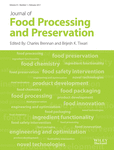Antioxidant Activity and Stability Study of Peptides from Enzymatically Hydrolyzed Male Silkmoth
Abstract
The antioxidant activity and stability of peptides from male silkmoth hydrolysates (MSH) was studied as antioxidant ingredients in potential food applications. MSH were isolated into five fractions: MSH-I (MW > 30 kDa), MSH-II (10–30 kDa), MSH-III (5–10 kDa), MSH-IV (3–5 kDa), and MSH-V (<3 kDa) by ultrafiltration. The antioxidant activity, molecular weight distribution and amino acid contents of each fraction were evaluated. The effects of NaCl, temperature, pH, light intensity and simulated gastrointestinal digestion were assessed to determine the stability of peptides. The antioxidant capacity of MSH-I as a major antioxidant component was 1,950 µmol/g in ORAC assay and 275 µmol/g in DPPH scavenging method. MSH showed good stability when salinity was less than 4%, temperature below 60C, and pH between 4 and 8. The antioxidant activity could retain about 80% after simulated gastrointestinal digestion. In conclusion, the MSH is a promising resource for stable antioxidant peptides applied in functional food processing and storage.
Practical Applications
In sericulture, the total cocoon yield has been 738,100 tons, the silk yield has been 93,000 tons, even about 60,000 tons of tussah moth cocoons produced in China in 2005. However, accompanied by the ascension of the silk consumpution, the sonsiderable amount of by-product and sericulture waste presented rising trend yearly.
While, moth as insect having allergy protein, which use has been limited, but it has an excellent protein and active peptides and other ingredients (to improve immunity and sexual function), comprehensive utilization of silkmoth turns into meaningful topics.
Using enzyme technology or fermentation technology (Protein degradation) to develop its protein resource utilization in silkmoth becomes the effective tools to solve this problem. The present experiments studied antioxidant activity by ultrafiltration technology and stability study of peptides from enzymatically hydrolyzed male silkmoth.




